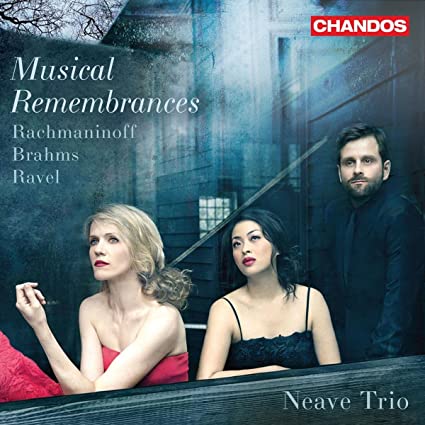

Sergei Rachmaninov: Trio Élégiaque No. 1 in G minor Johannes Brahms: Trio No. 1 in B major, Op. 8 Maurice Ravel: Trio in A minor, M 67
Like the rhythmic clickety clack of a funereal train slowly departing on its long and solemn journey, the cello and violin set the funeral cortège in motion, carrying the remains of a loved one to its distant burial grounds. The piano intones the impassioned, ascending four-note motif that will lead the beloved to its final resting place. Thus begins the highly evocative Trio Élégiaque No. 1 in G minor by Sergei Rachmaninov (1873-1943). Composed when he was barely out of his teens, it certainly bears all the earmarks of the mature composer, inspired by darker emotions and reflections. The Neave Trio, Anna Williams (violin), Mikhail Veselov (cello) and Eri Nakamura (piano), certainly sink their teeth into its more intensely anguished passages, which drives home the fact that when the train reaches its intended destination, during the gripping final two minutes of this single-movement work, it's a sad moment indeed.
As for the Trio No. 1 in B major, Op. 8 by Johannes Brahms (1833-1897), it's the Adagio movement that is the nucleus of the work, and the members of the Neave Trio certainly instil into it all the heartfelt longing and tenderness that Brahms was susceptible to, as well as bring out the pinpoint rhythmic accuracy required to deliver its effective Scherzo movement.
I've always considered the music of French composers to be characterized by motion, shifting colors, blue notes and quirky rhythms. The Trio in A minor by Maurice Ravel (1875-1937) is no exception. The Neave Trio even seem to uncover some exotic perfumes, a recurring signature of Ravel's music, within the pages of its first movement. They also well project the bursts of emotion in the middle of the slow movement marked Passacaille, which in the end fades to nil. The highly animated final movement brings the whole program to a riveting and flamboyant finish.
A well rounded trio of trios that even well seasoned chamber music enthusiasts could enjoy. And even those interested in getting acquainted with chamber music would find much to enjoy here, as each work casts a differing perspective on the genre, and the Neave Trio are excellent proponents of all three.
Jean-Yves Duperron - April 2022